 |
 |
 |
Does Fracking Cause Earthquakes?Introduction - Fracking, a method used in the oil and natural gas industry, allows for the extraction of more hydrocarbons and thus gives greater returns but there may be serious risks. Already identified as possible risks are contamination of ground water, effects on air quality, the release of gases and hydraulic fracturing chemicals at the surface and surface contamination from spills. But more importantly, fracking has now been officially identified as a possible contributor to earthquakes due to the resulting lubrication of faults. And, the surprising thing is that fracking is allowed as close as 500 feet from nuclear plants! This newsletter includes articles talking about the dangers of fracking and the still-dangerous situation in Japan. Also, several other threats to planet earth are covered. Note that I am simply sharing items of interest. That does not imply that I agree with everything presented. "And ye shall hear of wars and rumours of wars ... nation shall rise against nation, and kingdom against kingdom: and there shall be famines, and pestilences, and earthquakes ..." (Matt 24:6-7) Prophecy News - 2012 October
Fracking and Earthquakes
Nuclear Update: Fukushima Unit 4 Is Sinking (Unevenly) ... Fracking Now Allowed within 500 FEET of Nuclear Plants The spent fuel pool at Fukushima Unit 4 is the top short-term threat to humanity, and is a national security issue for America. As such, it is disturbing news that the ground beneath unit 4 is sinking. Specifically, Unit 4 sunk 36 inches right after the earthquake, and has sunk another 30 inches since then. Moreover, Unit 4 is sinking unevenly, and the building may begin tilting. An international coalition of nuclear scientists and non-profit groups are calling on the U.N. to coordinate a multi-national effort to stabilize the fuel pools. Given the precarious situation at Unit 4, it is urgent that the world community pool its scientific resources to come up with a fix. Earthquake-Causing Fracking to Be Allowed within 500 FEET of Nuclear Plants The American government has officially stated that fracking can cause earthquakes. Some fracking companies now admit this fact The scientific community agrees. Earthquakes can - of course - damage nuclear power plants. For example, even the operator of Fukushima and the Japanese government now admit that the nuclear cores might have started melting down before the tsuanmi ever hit. Indeed, the fuel pools and rods at Fukushima appear to have "boiled", caught fire and/or exploded soon after the earthquake knocked out power systems. Seethis, this, this, this and this. And fuel pools in the United States store an average of ten times more radioactive fuel than stored at Fukushima, have virtually no safety features, and are vulnerable to accidents and terrorist attacks. Indeed, American reactors may be even more vulnerable to earthquakes than Fukushima. But American nuclear "regulators" have allowed numerous nuclear power plants (represented by black triangles in the following diagram) to be built in earthquake zones: 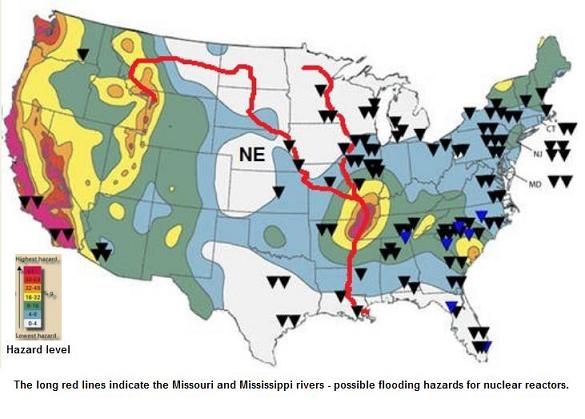 And they have covered up the risks from earthquakes for years ... just like the Japanese regulators did. For example:
For example, Diablo Canyon is located on numerous earthquake faults, and a state legislator and seismic expert says it could turn into California's Fukushima: On July 26th 2011 the California Energy Commission held hearings concerning the state's nuclear safety. During those hearings, the Chairman of the Commission asked governments experts whether or not they felt the facilities could withstand the maximum credible quake. The response was that they did not know. This is similar to what happened at Fukushima: seismologists dire warnings were ignored. Yet the Nuclear Regulatory Commission doesn't even take earthquake risk into account when deciding whether or not to relicense plants like Diablo Canyon. Are They Fracking With Us? American nuclear regulators are allowing earthquake-inducing fracking to be conducted mere feet from nuclear power plants. As the Herald Standard reports: Chesapeake Energy has a permit to frack just one mile from the Beaver Valley Nuclear Power Station in Shippingport. Whether that is cause for alarm, experts can't say. "Hydraulic fracturing near a nuclear plant is probably not a concern under normal circumstances," [Richard Hammack, a scientist at the Department of Energy's National Energy Technology Laboratory] said. "If there is a pre-stress fault that you happen to lubricate there (with fracking solution), that is the only thing that might result in something that is (seismically) measurable." That's not very reassuring, given that "lubrication" of faults is the main mechanism by which fracking causes earthquakes. (Indeed, the point is illustrated by the analogous fact that leading Japanese seismologists say that the Fukushima earthquake "lubricated" nearby faults, making a giant earthquake more likely than ever.) And as Akron Beacon Journal notes, fracking is allowed with 500 feet of nuclear plants: "We're not aware of any potential impacts and don't expect any," said FirstEnergy spokeswoman Jennifer Young today. "We see no reason to be particularly concerned." [But] experts can't say if the proposed well so close to two nuclear power plants is cause for concern. DEP spokesperson John Poister told the Shale Reporter that there are no required setbacks specifically relating to a required distance between such shale wells and nuclear facilities, just a blanket regulation requiring a 500-foot setback from any building to a natural gas well. And here is a reminder that Japan is still struggling with their nuclear disaster: Japan struggling to store radioactive water Japan's crippled nuclear power plant is struggling to find space to store tens of thousands of tonnes of highly contaminated water used to cool the broken reactors, the manager of the water treatment team has said. About 200,000 tonnes of radioactive water, enough to fill more than 50 Olympic-sized swimming pools, are being stored in hundreds of gigantic tanks built around the Fukushima Dai-ichi plant. Operator Tokyo Electric Power Company has already chopped down trees to make room for more tanks and predicts the volume of water will be more than triple within three years. "It's a time-pressing issue because the storage of contaminated water has its limits, there is only limited storage space" the water-treatment manager, Yuichi Okamura, told the AP news agency in an exclusive interview this week. Dumping massive amounts of water into the melting reactors was the only way to avoid an even bigger catastrophe. Okamura remembers frantically trying to find a way to get water to spent fuel pools located on the highest floor of the 50m high reactor buildings. Without water, the spent fuel is likely to have overheated and melted, sending radioactive smoke for miles and affecting possibly millions of people. The measures to keep the plant under control itself created another major problem for the utility: What to do with all that radioactive water that leaked out of the damaged reactors and collected in the basements of reactor buildings and nearby facilities. "At that time, we never expected high-level [radiation] contaminated water to turn up in the turbine building" Okamura said. Okamura was tasked with setting up a treatment system that would make the water clean enough for reuse as a coolant, and was also aimed at reducing health risks for workers and environmental damage. At first, the utility shunted the tainted water into existing storage tanks near the reactors. Contaminated Water Meanwhile, Okamura's 55-member team scrambled to get a treatment unit up and running within three months of the accident, a project that would normally take about two years, he said. Using that equipment, TEPCO was able to circulate reprocessed water back into the reactor cores. But even though the reactors now are being cooled exclusively with recycled water, the volume of contaminated water is still increasing, mostly because ground water is seeping through cracks into the reactor and turbine basements. Next month, Okamura's group plans to flip the switch on new purifying equipment using Toshiba Corp technology. "By purifying the water using the ALPS system, theoretically, all radioactive products can be purified to below detection levels" he said. But in the meantime its tanks are filling up, mostly because leaks in reactor facilities are allowing ground water pour in. Masashi Goto, nuclear engineer and college lecturer, said the contaminated water build-up posed a big, long-term health and environmental threat. He worried that the radioactive water in the basements may already be getting into the underground water system, where it could reach far beyond the plant via underground water channels, possibly in the ocean or public water supplies. "There are pools of some 10,000 or 20,000 tonnes of contaminated water in each plant, and there are many of these, and to bring all these to one place would mean you would have to treat hundreds of thousands of tons of contaminated water which is mind-blowing in itself," Goto said. "It's an outrageous amount, truly outrageous" Goto added. The plant also would have to deal with contaminated water until all the melted fuel and other debris is removed from the reactor, a process that will easily take more than a decade. Large April Quake Rattled the Globe 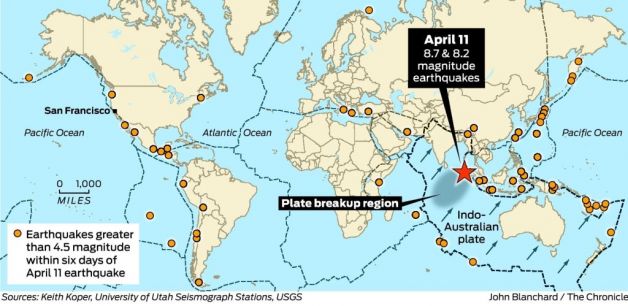 The April quake had struck in the same ocean region as the powerful and much more destructive quake of 2004, which had a magnitude of 9.1 and generated the tsunami that killed more than 200,000 people. "A huge earthquake that struck beneath the Indian Ocean in April triggered an extraordinary burst of large quakes around the world that alerted scientists to new seismic hazards everywhere. "It was a highly unusual event: At least four seismic faults deep underground off the island of Sumatra ruptured within 100 seconds to create a single giant quake with a combined magnitude of 8.7. No major problems occurred anywhere on land, but its effects worldwide call for a new assessment of global dangers, said scientists reporting in the current issue of Nature. Baja's Big One "Among the scores of temblors that followed for nearly a week, 16 were registered with magnitudes greater than 5.5, and one of the strongest, in Baja California, had a magnitude of 7.0, larger than the deadly Loma Prieta quake of 1989. "'While the likelihood of events this big is extremely rare, it tells us that when it's over it's not over, and that there's no such thing as an all clear,' said Ross Stein, a U.S. Geological Survey geophysicist and specialist in seismic hazards. "The number and size of the triggered quakes was 'astonishing,' Stein said. At least 16 quakes registered at magnitudes larger than 5.5, representing a sudden five-fold increase in seismic activity around the world, he noted. "Surface waves from the undersea quake -- known as Love waves -- raced across the world in three hours, triggering scores of small temblors, the scientists reported. Some faults as far away as Mexico and Japan ruptured six days later, with unusually strong ground shaking. "'We now know that quakes as big as the April one can be felt all over the world and can trigger other quakes everywhere when they are almost ready to fail,' he said." Click here to read it allAn Electromagnetic Pulse Attack -- the 'Other' Iranian Nuclear Threat 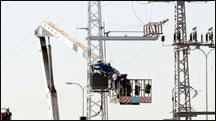 At risk? Israel's electric grid. "Just what might happen if the Iranians got their hands on a nuclear weapon? Would they fire it at an Israeli city, causing tens or hundreds of thousands of casualties? Or would they use it as a geopolitical weapon, seeking to dominate the Middle East and forcing the hand of Western powers, either subtly or by overtly threatening death and destruction to those who fail to heed their dictates? "While political scientists and world leaders have debated the likelihood of those two possibilities, there is a third plausible scenario: The use of a nuclear weapon by Iran to carry out an electromagnetic pulse (EMP) attack against Israel, the US, or Europe. Such an attack could cause severe damage to the electrical grid in the targeted nations, to the extent that the routines of daily life -- centered around the use of electrical power -- could be halted, for a short or even long period of time. "If Iran did opt for an EMP attack, the damage to Israel would be very high, she said. 'Iran doesn't have a nuclear bomb yet, and hopefully they won't have one, but if they do manage to build a bomb, an EMP attack is a real possibility,' Landau added. 'Many people in the US are concerned about EMP now, and although the public discussion hasn't begun in Israel yet, I expect that it will in the near future.'" Click here to read it allEuropean Society Struggles Under Weight of Financial Crisis  Switzerland, who has long prided itself on its political neutrality, is preparing for unrest in Europe. "Switzerland staged military exercises in eight towns across the country last month, in preparation for a complete breakdown in Europe. "In the 'Stabilo Due' exercises, Switzerland practiced dealing with spillover from warring factions from Europe or the sudden influx of refugees from Greece, Spain, Italy, France and Portugal. "'I can't exclude that in the coming years we may need the army,' said Swiss Defense Minister Ueli Maurer.'" Extreme Global Weather: "the Unprecedented Is the New Normal" 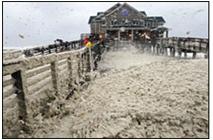 Superstorm Sandy - October 2012. A rising death toll, the catastrophic flooding and destruction of entire neighborhoods, and billions of dollars in property damage. The impact of Hurricane Sandy, which hit the East Coast earlier this week, will be felt for years, both in the United States and in the Caribbean region where it had earlier killed more than 70 people. Sandy is being called the "Storm of the Century" but floods, droughts, heat waves and storms are only expected to get worse - with every part of the world facing deadlier and costlier weather disasters. Much of the world has experienced devastating weather conditions this year. Across eastern and western Africa, a one-two punch of severe drought followed by torrential rains resulted in flash flooding and the deaths and displacement of hundreds of thousands. Drought was also the worst it's been in a quarter century in the United States, shriveling corn crops and boosting prices worldwide. And over the last week, typhoon Son-Tinh has wreaked havoc on Southeast Asia, killing dozens and damaging homes and crops. So what's causing these extreme weather events and their widespread devastation? A special report issued earlier this year by the IPCC - the Intergovernmental Panel on Climate Change - points to a combination of human-caused global warming, shifts in population, and poverty. And though political wrangling over global warming continues in the United States, 7 in 10 Americans now believe in the science behind climate change and how it can alter global weather conditions. Click here to read it allIran Threatens to Stop Oil Exports, Considers Anti-Europe Sanctions 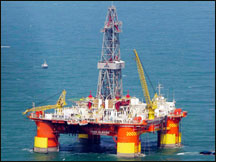 A general view of Iran's first offshore oil platform, Iran-Alborz, in the Caspian Sea near city of Neka about 392 km (245 miles) north of Tehran. "Iran warns that it could stop exporting oil, driving global crude prices up, should the US and allied Europe tighten sanctions further. For such a case, Tehran says, it has a contingency strategy to carry on without oil revenues. "'If you continue to add to the sanctions, we will stop our oil exports to the world,' Iranian Oil Minister Rostam Qasemi told reporters Tuesday. 'The lack of Iranian oil in the market would drastically add to the price.'" Click here to read it allClosest Asteroid in Recorded History to Pass Earth
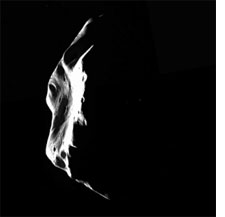 Asteroid 2012 DA14 will pass by Earth at a distance of 22,500 km on Feb. 15, 2013. SYDNEY -- An asteroid the size of a city block is due to come whizzing past Earth closer than any other of its size in recorded history in February next year, according to astronomers. The asteroid, referred to as 2012 DA14, has a diameter of approximately 45m and an estimated mass of 130,000 tonnes. It was discovered at the start of 2012 and is set to travel between the Earth and our geostationary communication satellites on 15 February 2013. At a distance of just 22,500km this will be the closest asteroid 'fly by' in recorded history. The destructive force of an atomic bomb "It is important to monitor all asteroids that pass close by in case any are on a collision course with Earth. NASA has identified 4,700 asteroids that are potential threats to us. "A collision with even a small asteroid could be disastrous, with an impact from 2012 DA14 estimated to equal the destructive force of an atomic bomb." Summary - We have more extremes in weather, increased seismic activity (with fracking likely to produce even more), the continued threat of widespread radioactive contamination, a continuation of the buildup towards another Middle East war with a high probability of spreading and, to top it all off, a risk of getting clobbered from outer space. Doesn't all that just make you look forward to the new heavens and new earth that will replace this tired old world? "And when these things begin to come to pass, then look up, and lift up your heads; for your redemption draweth nigh." (Luke 21:28) If prophecy of the end of the world is of interest to you and you would like to receive this monthly newsletter containing articles of interest and relevance to prophetic events, please respond using the form below: |
Prophecy Newsletter
Receive
free newsletters
reporting and analysing world events related to prophecy.
The Greek has multiple words for forgiveness? God forgives (charizomai) whether we ask or not. Receiving forgiveness (apheimi) is by our choice.
God always forgives!
|
|
|
|
||
|
| ||

New! Comments
Have your say about what you just read! Please leave a comment below.